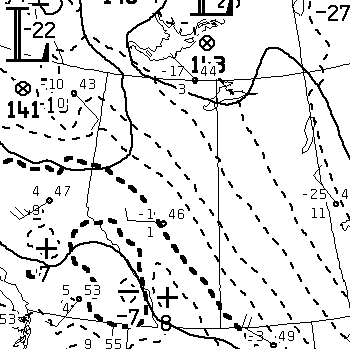| Activity/Topic | |
|---|
| Prepare a short range (e.g. 48-hr) weather forecast based on NWP guidance (repeating exercise) | ✔ |
| Prepare a short range (e.g. 48-hr) weather forecast without NWP guidance | ✔ |
| Calculations using hydrostatic law, ideal gas law, sat.vap. press. tables | ✔ |
| Compute geostrophic wind from height contour spacing | ✔ |
| Compute rate of temperature advection | ✔ |
| Plot a sounding | ✔ |
| Use the skew-T chart to compute various properties (LCL, LFC, potential temperatures etc.) | ✔ |
| Plot time series of thickness alongside time series of layer-mean temperature | Assig. 1 |
| Plot hodograph; add wind vectors V1, V2 and thermal wind VT21=V2-V1; infer (probable) location of colder air | ✔ |
| Deduce GOES ir cloud top height from ir target T, using sounding | ✔ |
| Plot a cross-section from radiosonde data at stations along a transect | ✔ |
| Plot differential met. fields (e.g. moisture convergence) from archived (recent or historic) data | |
| Analyses and forecasts of vertical motion available from NWP models | ✔ |
| Compare NWP fields for vorticity advection, horiz. divergence, thermal advection & vertical motion (context: QG paradigm) | Assig. 2 |
| Examples of frontogenesis in relation to deformation | ✔ |
| Compute crop evapotranspiration (vertical eddy flux of water vapour) from time series of velocity and humidity | Assig. 3 |
| Plot diurnal cycle of components of the surface energy budget | |
| Change in heat storage inferred from subsequent soundings. Implied 12-hr mean surface heat flux | |
| Generate weather chart(s) for a past day from web-accessible archive (reanalysis) | |
| Generate chart giving climatological contours (e.g. isobaric height, or thickness) from web-accessible archive | ✔ |
| Online computation/display of air parcel back-trajectories based on NWP wind fields | ✔ |
Compute a histogram and probability density function from given data | |
Calculating Heidke skill score | |
| Student weather briefings (teams of 2) | |
| Theme | Activity/Topic |
|---|
| Vocabulary & meaning of equations | Transport equations: derive statements of conservation of heat and of mass in Cartesian coordinates. Express these in vector notation. Unit vectors. Grad operator. Laplacian operator. Fourier's and Fick's laws. Heat equation. Diffusion equation. | ✔ |
| Lagrangian derivative. Conserved variables. Conservation of thermodynamic energy. Velocity divergence | ✔ |
| The equations of motion in vector form; in component form relative to local rotating Cartesian coordinates | ✔ |
| Atmospheric Paradigms | Geostrophic wind model | ✔ |
| Continuity equation in isobaric coordinates. Height-integrated continuity equation. Relationship between horizontal divergence and vertical motion. Level(s) of non-divergence | ✔ |
| Thermal wind | ✔ |
| The quasi-geostrophic model. Vorticity equation. Height tendency equation. Omega equation. Q-vector. Significance of vorticity advection and thermal advection | ✔ |
| Isentropic potential vorticity and the "dynamic troposphere" | |
| Everyday tools | Thermodynamic chart. Hodograph | ✔ |
| Hypsometric equation. Dry adiabatic lapse rate. Natural coordinate system | ✔ |
| Potential temperature. Thermodynamic chart. Energetics of vertical motion | ✔ |
| Water vapour calculations. Dewpoint lapse rate. Mixing ratio lines on the thermodynamic chart | ✔ |
| METARs, meteograms, TAF, PIREP, Graphical Area Forecast (GFA) | ✔ |
| Vertical motion on the synoptic scale. Relationship with precipitation. Precipitable water. Vertical flux of water vapour | ✔ |
| Further differential properties of the wind field: deformation | ✔ |
| Satellite data | GOES, POES and exotic meteorological satellites | ✔ |
| Unresolved motion & ABL | Decomposition into resolved/unresolved scales of motion. Fundamental view of friction. The closure problem. Eddy diffusion parameterization | ✔ |
| Heat, mass and momentum exchange between the surface and the free troposphere. Unresolved ("turbulent") vertical fluxes in the atmospheric boundary layer. | ✔ |
| The surface layer ("constant flux layer"). Elements of Monin-Obukhov theory. The surface energy balance | ✔ |
| Heat budget of the horizontally-uniform atmospheric boundary layer | ✔ |
| Fronts & frontogenesis | ✔ |
| NWP | MSC's Global Environmental Multiscale model - model dynamics | ✔ |
| MSC's GEM model - parameterizations | ✔ |
| NCEP's short range NAM/WRF model | ✔ |
| NCEP's long range GFS (Global Spectral) model | ✔ |
| Reanalyses, reforecasts, downscaling | |
